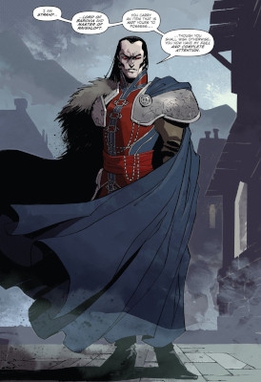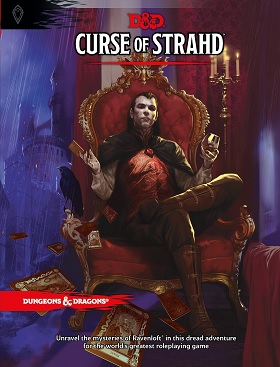Related Research Articles

Ravenloft is a campaign setting for the Dungeons & Dragons roleplaying game. It is an alternate time-space existence known as a pocket dimension or demiplane, called the Demiplane of Dread, which consists of a collection of land pieces called "domains", brought together by a mysterious force known only as the Dark Powers. Each domain is tailored to and mystically ruled by a being called a Darklord who is forever trapped and surrounded by magical mists surrounding the domain. Strahd von Zarovich, a vampire in the original AD&DRavenloft I6 module released in 1983, became the first Darklord, both ruler and prisoner of his own personal domain of Barovia. The story of how Count von Zarovich became Darklord of Barovia was detailed in the 1993 novel I, Strahd: The Memoirs of a Vampire. As originally established in the Ravenloft: Realm of Terror boxed set known as "the Black Box" released in 1990, the Ravenloft campaign setting was located in the Ethereal Plane. As a physical manifestation of that plane, lands, monsters and even people were created out of the mysterious mists, and the realm acted as a prison where one could enter or be transported, but means of escape were few. Other Ravenloft Domains and Darklords were eventually added in various AD&D 2nd edition products establishing a core continent attached around Barovia which could be traveled to by others if their respective lords allowed entering or leaving their borders; while some Domains remained isolated in the mists and were referred to as Islands.

In the Dungeons & Dragons fantasy role-playing game, illithids are monstrous humanoid aberrations with psionic powers. In a typical Dungeons & Dragons campaign setting, they live in the moist caverns and cities of the enormous Underdark. Illithids believe themselves to be the dominant species of the multiverse and use other intelligent creatures as thralls, slaves, and chattel. Illithids are well known for making thralls out of other intelligent creatures, as well as feasting on their brains.

Ravenloft is an adventure module for the Dungeons & Dragons (D&D) fantasy role-playing game. The American game publishing company TSR, Inc. released it as a standalone adventure booklet in 1983 for use with the first edition Advanced Dungeons & Dragons game. It was written by Tracy and Laura Hickman, and includes art by Clyde Caldwell with maps by David Sutherland III. The plot of Ravenloft focuses on the villain Strahd von Zarovich, a vampire who pines for his lost love. Various story elements, including Strahd's motivation and the locations of magical weapons, are randomly determined by drawing cards. The player characters attempt to defeat Strahd and, if successful, the adventure ends.

Lord Soth, the Knight of the Black Rose, is a fictional character appearing in the fantasy realms of Dragonlance and later Ravenloft. He is depicted as a death knight and fallen Knight of Solamnia from the world of Krynn.

Count Strahd von Zarovich is a fictional character originally appearing as the feature villain in the highly popular Advanced Dungeons and Dragons adventure module I6: Ravenloft. Later, this character and his world would be explored in follow-up modules, novels, and the Ravenloft campaign setting. Within this setting, Strahd is the first and best-known of Ravenloft's darklords. He is a powerful ancient vampire. He is also a master necromancer, a skilled warrior, and the unquestioned ruler of the domain of Barovia.
Darklord is a title used to refer to the mystically imprisoned and cursed ruler of a domain in Ravenloft, a campaign setting in the Dungeons & Dragons role-playing game.

James Wyatt is a game designer and a former United Methodist minister. He works for Wizards of the Coast, where he has designed supplements and adventures for the Dungeons & Dragons (D&D) roleplaying game. He is the author of sci-fi and fantasy novels, including Forgotten Realms books, and the 4th edition Dungeon Master's Guide.
The flexibility of the Dungeons & Dragons (D&D) game rules means that Dungeon Masters (DM) are free to create their own fantasy campaign settings. For those who wanted a pre-packaged setting in which to play, TSR, Wizards of the Coast (WotC), and other publishers have created many settings in which D&D games can be based; of these, the Forgotten Realms, an epic fantasy world, has been one of the most successful and critically acclaimed settings. Many campaign settings include standard sword and sorcery environments, while others borrow Asian, Central American, swashbuckling, horror and even space-travel themes.
The lich is an undead creature found in the Dungeons & Dragons (D&D) fantasy role-playing game. Liches are spellcasters who seek to defy death by magical means.
In the Dungeons & Dragons fantasy role-playing game, a vampire is an undead creature. A humanoid or monstrous humanoid creature can become a vampire, and looks as it did in life, with pale skin, haunting red eyes, and a feral cast to its features. A new vampire is created when another vampire drains the life out of a living creature. Its depiction is related to those in the 1930s and 1940s Hollywood Dracula and monster movies. In writing vampires into the game, as with other creatures arising in folklore, the authors had to consider what elements arising in more recent popular culture should be incorporated into their description and characteristics.
The role-playing game Dungeons & Dragons (D&D), which receives significant attention in the media and in popular culture, has been the subject of numerous controversies. The game sometimes received unfavorable coverage, especially during its early years in the early 1980s. Because the term D&D may be mistakenly used to refer to all types of role-playing games, some controversies regarding D&D mistakenly pertain to role-playing games in general, or to the literary genre of fantasy. Some controversies concern the game and its alleged impact on those who play it, while others concern business issues at the game's original publisher, TSR. The game is now owned by Wizards of the Coast.

Vampire of the Mists is the first novel in the Ravenloft books gothic horror series. Written by Christie Golden, it is set both in Waterdeep, a city in the Forgotten Realms world of Dungeons & Dragons, and more prominently, the Demiplane of Dread, location of the Ravenloft campaign setting.
House of Strahd is an adventure module for the 2nd edition of the Advanced Dungeons & Dragons fantasy role-playing game, published in 1993.

Ravenloft: Realm of Terror is a boxed set accessory published in 1990 for the Ravenloft campaign setting for the Advanced Dungeons & Dragons fantasy role-playing game.
Chuck Lukacs is an artist whose work has appeared in role-playing games.

Bruce Nesmith is a game designer who has worked primarily on role-playing games. He was Creative Director at TSR, working on a variety of games including Dungeons & Dragons, and is a senior game designer at Bethesda Game Studios, where he has worked on AAA titles such as Fallout 3, Fallout 4 and Elder Scrolls IV: Oblivion, and was lead designer on Elder Scrolls V: Skyrim.

Curse of Strahd is an adventure book for the 5th edition of the Dungeons & Dragons role-playing game. It was released on March 15, 2016 and is based on the Ravenloft module published in 1983.

Van Richten's Guide to Ravenloft is a sourcebook that details the Domains of Dread from the Ravenloft campaign setting for the 5th edition of the Dungeons & Dragons fantasy role-playing game.
References
- 1 2 3 4 5 6 Muncy, Julie (July 27, 2020). "D&D's Culturally Sensitive Strahd Revamp Is Here, But It'll Cost You [Updated]". io9. Retrieved 2020-11-21.
- 1 2 Ryan, Jon (July 27, 2020). "Exclusive: First Look at D&D's 'Curse of Strahd Revamped' Collector's Edition". IGN . Retrieved 2020-11-21.
- ↑ Appelcline, Shannon. "Ravenloft Campaign Setting, Revised, Boxed Set (2e) | Product History". DriveThruRPG. Retrieved 2021-05-13.
- 1 2 3 Hall, Charlie (2021-05-18). "Dungeons & Dragons retcons one of its most problematic characters". Polygon. Retrieved 2021-05-18.
- ↑ "Is Dungeons & Dragons Getting Ready to Return to Ravenloft?". ComicBook.com. August 6, 2020. Retrieved 2021-05-14.
- ↑ "Curse Of Strahd Revamped: What It Changes From The Original". TheGamer. 2020-10-22. Retrieved 2021-05-14.
- ↑ Macgregor, Jody (2020-08-03). "Popular D&D tabletop campaign Curse of Strahd is being re-'vamped'". PC Gamer. Retrieved 2020-11-21.
- ↑ Rocket, Stubby the (2020-06-29). "Wizards of the Coast Takes Steps Towards Changing Racist Dungeons & Dragons Content". Tor.com. Retrieved 2021-02-24.
- ↑ "Dungeons & Dragons Team Announces New Plans to Address Race and Inclusivity in the Game". io9. June 18, 2020. Retrieved 2021-02-24.
- ↑ King, Marley (2021-08-02). "Why D&D's Vistani Are Still Problematic". ScreenRant. Retrieved 2021-09-26.